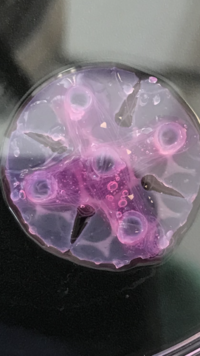Bioactuator
Contents
Introduction
Our goal is to make a functional biohybrid design that can preform locomotion. To manage this, the goal is to use a complex skeleton with one or multiple simple one-way flexing skeleton muscle tissue.
The cells used are the C2C12 myoblast cancer cell line from rats. The C2C12 cell line are progenitor cells (myoblasts), these cells will grow as long as there are vital substances, space and a healthy environment in the growth flask. But once the cells are confluent they will differentiate into skeletal muscle cells, the cells can also be induced to differentiate.
The "skeleton" part of the bioactuator is made out of polydimethylsiloxane (PDMS), there is also possible to use other materials such as Elastic 50A (see Fig. 2).
To achieve the desired shape of the muscle tissue and skeleton, we design moulds in Fusion 360 and 3D print them, the moulds are made of polycarbonate. If the mould is made for muscle tissue it is important to keep it hospitable for cells (e.g by coating it and keeping it sterile). When we fill the moulds with skeletal muscle cells we also add collagen 1 this is called 3D culturing. Collagen 1 is added because it is a major part of the extracellular Matrix (ECM). Collagen 1 can also be used to coat the moulds.
Stimulation
To make the muscle contract it is stimulated with an electrical current that makes the muscle contract. We use a pulse generator to stimulate the cells.
Maintenance of cells, engineering of moulds and electrical stimulation is therefore the main parts of this project.
Team progress
The original team started off with four undergraduate students, with three of us studying bioscience and one studying physics. The supervisors were two postdocs at Domus Medica. The group went through different changes in students and supervisors, and not all of their progress has been documented properly on this Wiki.
The new group of students that joined the project in 2023 made a more extensive log of their findings, which is now uploaded on the Wiki here.
2021-2022 group
-We have managed to fill the moulds with the collagen type 1 and cell mixture. Our next goal is to electrical stimulate the skeleton muscle cells in 2D culture.-The electrical stimulation was successful. We have been working on on a couple of designs but we have now come to the conclusion that we will mainly work on the medusoid design. We will also start working with Kayoko Shoji's muscle fibers.
-We have now made two medusoid designs, one with groves where we fill the muscle cell mixture and one with pillars which we twirl the muscle fibers around. Our next goal is to do electrical stimulation on these design(3D stimulation).
-The 3D stimulation ended with the muscle tissue being ruptured by it's own force, we will try to reduce the amount of cells in the cell mixture or add an extra layer of collagen on top.
2023 group
Bioactuator group that was active during 2023, collected some experimental notes and observations which can be accessed here.
General introductory literature
- https://www.nationalgeographic.com/science/article/robotic-living-muscle-tissue-science
-https://doi.org/10.1038/nbt.2269

